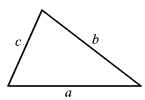C Program to determine the type and Area of a Triangle
Last updated on July 27, 2020
The following is a C Program to determine the type and Area of a Triangle:
1 2 3 4 5 6 7 8 9 10 11 12 13 14 15 16 17 18 19 20 21 22 23 24 25 26 27 28 29 30 31 32 33 34 35 36 37 38 39 40 41 42 43 44 45 46 47 48 49 50 51 52 53 54 55 56 57 58 59 60 | /*****************************************************
Program to determine the type and area of a triangle
*****************************************************/
#include<stdio.h> // include stdio.h library
#include<math.h> // include math.h library
int main(void)
{
float a, b, c, s, area;
printf("Enter sides of a triangle: \n");
printf("a: ");
scanf("%f", &a);
printf("b: ");
scanf("%f", &b);
printf("c: ");
scanf("%f", &c);
// sum of any two sides must be greater than the third side
if( (a + b > c) && (b + c > a) && (c + a > b) )
{
// three sides are equal
if( (a == b) && (b == c) )
{
printf("Triangle is equilateral.\n");
}
// two sides are equal
else if( (a == b) || (b == c) || (a == c) )
{
printf("Triangle is isosceles.\n");
}
// no sides are equal
else
{
printf("Triangle is scalene.\n");
}
// area of triangle using heron's formula https://en.wikipedia.org/wiki/Heron's_formula
s = (a + b + c) / 2; //semi perimeter
area = sqrt( s * (s - a) * (s - b) * (s - c) ); // area
printf("Area of triangle %.2f.", area);
}
else
{
printf("Sides don't make a triangle.");
}
return 0; // return 0 to operating system
}
|
Expected Output:
1st run:
1 2 3 4 5 6 | Enter sides of a triangle:
a: 3
b: 4
c: 5
Triangle is scalene.
Area of triangle 6.00.
|
2nd run:
1 2 3 4 5 | Enter sides of a triangle:
a: 4
b: 5
c: 1
Sides don't make a triangle.
|
How it works #
The above program uses two theorems:
- Triangle Inequality Theorem
- Heron's Formula
Triangle Inequality Theorem #
The Triangle Inequality Theorem states that the sum of two sides of a triangle must be greater than the third side.

Let a, b c be the three sides of the triangle then according to Triangle Inequality theorem:
1 2 3 | a + b > c
b + c > a
c + a > b
|
We can also use Triangle Inequality theorem to determine whether the given three line segments can be used to construct a triangle or not.
In order for three line segments to form the sides of a triangle, all the three conditions must be satisfied.
If any one of the condition fails then the given line segments can't be used to construct a triangle. For example:
Example 1: Can we construct a triangle using the following lengths: 7, 3, 2?
1 2 3 | 7 + 3 > 2 => true
3 + 2 > 7 => false
7 + 2 > 3 => true
|
The second condition is false. Hence, lengths 7,3 and 2 can't construct a triangle.
Example 2: Can we construct a triangle using the following lengths: 3, 4, 5?
1 2 3 | 3 + 4 > 5 => true
4 + 5 > 3 => true
5 + 3 > 4 => true
|
All the three conditions are true. Hence, lengths 3, 4, 5 can be used to construct a triangle.
Heron's Formula #
Heron's Formula allows us to find the area of the triangle using the length of the three sides.
\begin{gather*}
Area=\sqrt{s(s-a)(s-b)(s-c)}
\end{gather*}
where s is called the semi perimeter of the triangle and is calculated as follows:
\begin{gather*}
s=\frac{a+b+c}{2}
\end{gather*}
Load Comments